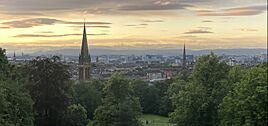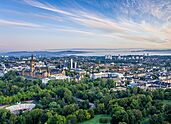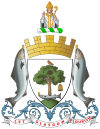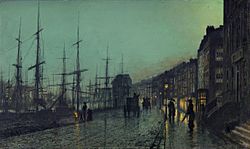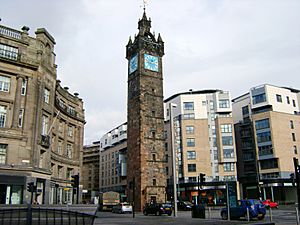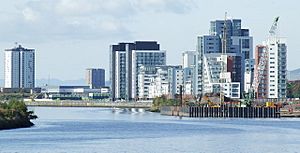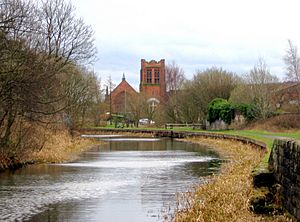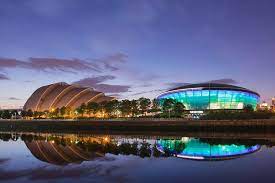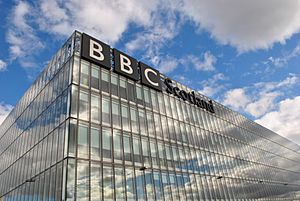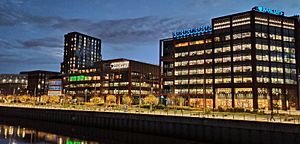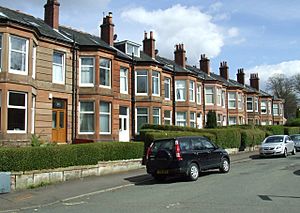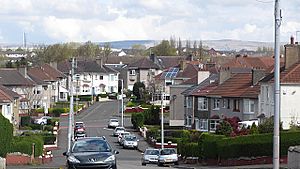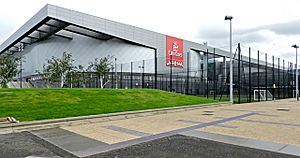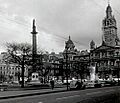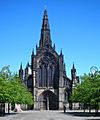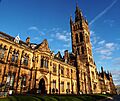Glasgow facts for kids
Quick facts for kids
Glasgow
|
|||
|---|---|---|---|
|
City, lieutenancy and council area
|
|||
|
Glasgow from Queen's Park
Glasgow Green
|
|||
|
|||
| Nickname(s):
The Dear Green Place, Scottish Gaelic: Baile Mòr nan Gàidheal
|
|||
| Motto(s):
Let Glasgow Flourish
|
|||
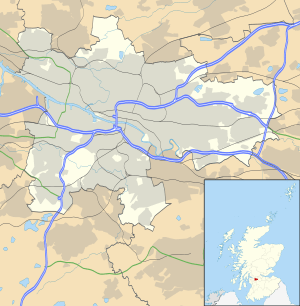
Glasgow shown within Scotland
|
|||
| Sovereign state | United Kingdom | ||
| Country | Scotland | ||
| Founded | Late-6th century | ||
| Burgh charter | 1170s | ||
| Unitary authority | 1 April 1996 | ||
| Administrative HQ | Glasgow City Chambers | ||
| Government | |||
| • Type | Council | ||
| • Body | Glasgow City Council | ||
| Area | |||
| • Total | 68 sq mi (175 km2) | ||
| Area rank | 26th | ||
| Population
(2022)
|
|||
| • Total | 622,820 | ||
| • Rank | 1st | ||
| • Density | 9,240/sq mi (3,567/km2) | ||
| Demonym(s) | Glaswegian | ||
| Time zone | UTC+0 (GMT) | ||
| • Summer (DST) | UTC+1 (BST) | ||
| Postcode areas | |||
| Dialling codes | 0141 | ||
| ISO 3166 code | GB-GLG | ||
| GSS code | S12000049 | ||
Glasgow is the largest city in Scotland, located on the River Clyde in west central Scotland. It is also the third-most-populous city in the United Kingdom. In 2022, Glasgow had an estimated population of over 620,000 people. The wider area, known as Greater Glasgow, is home to over 1.8 million people, which is about one-third of Scotland's total population.
Glasgow started as a small village near Glasgow Cathedral. It grew to become Scotland's biggest seaport. In the 15th century, the University of Glasgow was founded, making the city an important place for learning. From the 18th century, Glasgow became a major trading hub, especially with North America and the West Indies. During the Industrial Revolution, Glasgow grew very quickly. It became a world leader in chemicals, textiles, and engineering, especially in shipbuilding. For a long time, Glasgow was known as the "Second City of the British Empire".
Today, Glasgow is famous for its culture. It has many international institutions like the Royal Conservatoire of Scotland and the Royal Scottish National Orchestra. The city was named the European Capital of Culture in 1990. It's known for its amazing buildings, lively culture, media, music scene, sports teams, and great transport links. It is one of the most visited cities in the UK. Glasgow is also well-known for its football, especially the exciting rivalry between its two main teams, Celtic and Rangers.
Contents
- Understanding Glasgow's Name and Symbols
- Exploring Glasgow's Past: A Journey Through Time
- Exploring Glasgow's Geography and People
- Exploring Glasgow's Neighbourhoods
- Glasgow's Vibrant Culture and Arts
- Glasgow's Economy and Jobs
- Getting Around Glasgow: Transport Links
- Housing in Glasgow
- Healthcare in Glasgow
- Learning and Education in Glasgow
- Sports in Glasgow: A City of Champions
- Notable Incidents and Events
- Glasgow's Global Connections
- Images for kids
- See also
Understanding Glasgow's Name and Symbols
| The coat of arms of the City of Glasgow | |
|---|---|
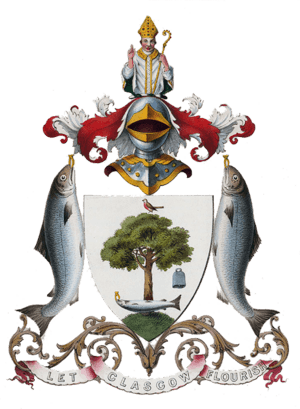 |
|
| Adopted | 1866 |
| Crest | Saint Mungo |
| Supporters | Two salmon, bearing rings |
| Motto | Let Glasgow Flourish by the preaching of Your word, and the praising of Your name. |
The name Glasgow comes from an old language called Brittonic. Glas means "grey-green" or "grey-blue," and *cöü means "hollow." So, Glasgow likely means "green-hollow." People often say it means "dear green place," which is a lovely way to describe the city. The modern Gaelic name for Glasgow is Glaschu.
The city's coat of arms was given in 1866. It features symbols linked to Saint Mungo, Glasgow's patron saint. These symbols represent miracles Mungo was said to have performed. They are remembered in a rhyme:
-
-
-
- Here's the bird that never flew
- Here's the tree that never grew
- Here's the bell that never rang
- Here's the fish that never swam
-
-
Saint Mungo also preached a sermon with the words: Lord, Let Glasgow flourish by the preaching of the word and the praising of thy name. This was shortened to "Let Glasgow Flourish" and became the city's motto.
In 1450, Glasgow's first leader, John Stewart, paid for a "St Mungo's Bell." This bell would ring throughout the city. A new bell bought in 1641 is now on display at the People's Palace Museum.
Exploring Glasgow's Past: A Journey Through Time
How Glasgow Began and Grew
People have lived in Glasgow for a very long time, since prehistoric times. It was a good place to settle because it was the furthest point down the River Clyde where people could cross it easily. After the Romans left, Glasgow was part of the Kingdom of Strathclyde.
Glasgow became important in the 10th and 11th centuries as a major church area. In the 6th century, Saint Mungo built a church here, and a large community grew around him. This community became known as Glasgu.
Between 1175 and 1178, Bishop Jocelin helped Glasgow become a "burgh." This meant it had special trading rights and legal protections, helping it grow. An annual fair, the Glasgow Fair, also started around this time.
The city continued to grow. The first bridge over the River Clyde was built around 1285. In 1451, the University of Glasgow was founded, boosting the town's importance. Early trade involved farming, brewing, and fishing, with salmon and herring sent to Europe.
After Scotland joined with England in 1707 (the Acts of Union), Glasgow gained access to the huge markets of the British Empire. It became a key centre for trade with the Americas, dealing in sugar, tobacco, cotton, and manufactured goods. The city's wealthy "Tobacco Lords" even created a deep water port at Port Glasgow because the river in the city was too shallow.
Glasgow's Industrial Boom and Changes
The opening of the Monkland Canal in 1795 helped Glasgow access coal and iron from Lanarkshire. After the River Clyde was made deeper, shipbuilding became a huge industry. Famous shipbuilders like Robert Napier and John Elder built many innovative ships here.
By 1821, Glasgow's population was bigger than Edinburgh's. The city also created one of the world's first police forces in 1800. By the late 19th century, Glasgow was known as the "Second City of the Empire." It produced more than half of Britain's ships and a quarter of the world's locomotives. Besides shipbuilding, Glasgow was also a major centre for chemicals, textiles, and engineering.
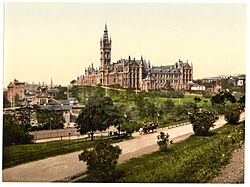
Glasgow became one of the first European cities to reach a population of one million. Many people moved to Glasgow from other parts of Scotland, Ireland, and Europe for work.
During this time, many grand buildings were built, like the Glasgow City Chambers and the Kelvingrove Art Gallery and Museum. The city also hosted several big international exhibitions.
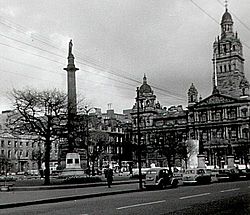
The 20th century brought challenges. After World War I and during the Great Depression, Glasgow faced economic difficulties. However, it recovered during World War II and the 1950s. By the 1960s, competition from other countries led to a decline in Glasgow's traditional industries.
This led to a period of economic decline, high unemployment, and a shrinking population. To fix this, the city started a huge rebuilding program in the 1950s. Old, crowded areas were torn down, and people moved to new housing estates and tower blocks.
By the late 1980s, Glasgow's economy started to improve. Campaigns like "Glasgow's miles better" helped attract tourists and new businesses. The opening of the Burrell Collection in 1983 and the Scottish Exhibition and Conference Centre in 1985 helped Glasgow become a European hub for business and tourism. The city also hosted the Glasgow Garden Festival in 1988 and was the European City of Culture in 1990.
Today, Glasgow is still working on improving its inner-city areas. While some parts are thriving, others still face challenges like poverty. However, the city continues to attract visitors and investment.
Exploring Glasgow's Geography and People
Where Glasgow is Located and Its Weather
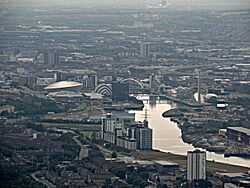
Glasgow is on the banks of the River Clyde in West Central Scotland. Another important river is the River Kelvin, which flows into the Clyde. The Kelvin River gave its name to the famous physicist Baron Kelvin.
Glasgow has an oceanic climate, which means it has mild winters and cool summers. Even though it's quite far north, like Moscow, the Gulf Stream keeps it warmer than other places at the same latitude.
Glasgow is known for its rain, with about 170 rainy days a year. Winters are cool and cloudy, with temperatures sometimes dropping below freezing. Snow doesn't usually stay for long. Summers are mild, with average highs around 20°C (68°F) in July. Very hot days are rare.
How Glasgow's Population Has Changed
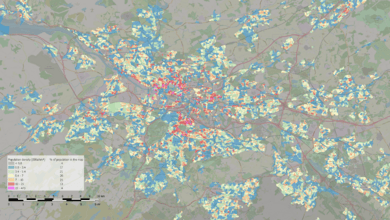
In the 1950s, Glasgow's population was over 1 million, making it one of the most crowded cities in the world. After the 1960s, many people moved out of the city centre to new towns like East Kilbride and Cumbernauld. This caused the population to decrease.
Today, the city council area has about 593,000 people. However, the larger Greater Glasgow urban area, which includes nearby towns, has over 985,000 people.
In the 18th and 19th centuries, many people moved to Glasgow for work, especially from Ireland. Later, in the 20th century, people from Lithuania and Italy also settled here. In the 1960s and 1970s, many people from Asia, including Pakistan, India, Bangladesh, and China, made Glasgow their home. More recently, people from Poland and asylum seekers from various countries have also moved to the city.
Since 2001, Glasgow's population has started to grow again due to people moving from other parts of Scotland and from overseas.
Exploring Glasgow's Neighbourhoods
The Bustling City Centre
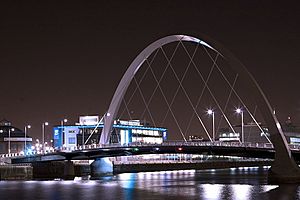
Glasgow's city centre is laid out in a grid pattern. The main square is George Square, which has many statues and the grand Victorian Glasgow City Chambers, where the city council meets.
The city centre is a major shopping destination, with popular streets like Argyle Street, Sauchiehall Street, and Buchanan Street. Buchanan Street is known for its more upscale shops and has won awards for being a great street. Together, these areas are called "The Style Mile."
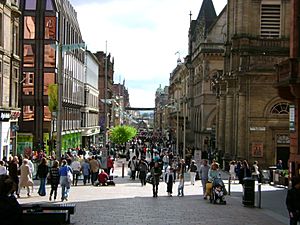
Many of Glasgow's cultural venues are in the city centre, including the Glasgow Royal Concert Hall, the Theatre Royal, and the Gallery of Modern Art (GoMA). You can also find four of Glasgow's universities and colleges here: the University of Strathclyde, the Royal Conservatoire of Scotland, Glasgow School of Art, and Glasgow Caledonian University.
The Historic Merchant City
The Merchant City was once where wealthy merchants lived and worked in the 18th and early 19th centuries. Many streets here are named after the "Tobacco Lords" who traded internationally.
The original centre of Glasgow was Glasgow Cross, marked by the Tolbooth Steeple. Nearby is the 15th-century Glasgow Cathedral. As the city grew, people moved to newer areas, leaving the old centre behind.
Since the 1980s, the Merchant City has been brought back to life with modern apartments and many cafes and restaurants. It's also home to a growing "cultural quarter" with art galleries, theatres, and concert venues like the City Halls.
The Vibrant West End
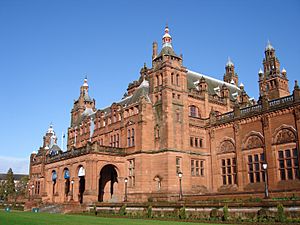
Glasgow's West End is known for its elegant buildings, cafes, shops, and restaurants. It's a popular area for tourists and students, especially around Kelvingrove Park, the University of Glasgow, and Glasgow Botanic Gardens.
The spire of the University of Glasgow's main building, a large Gothic Revival building, is a famous landmark that can be seen from far away. The university is one of the oldest in the English-speaking world.
The West End also has the Kelvingrove Art Gallery and Museum and the new Riverside Museum, which celebrates Glasgow's industrial past. The West End Festival, one of Glasgow's biggest festivals, happens here every June. The SECC and the OVO Hydro arena, a major concert venue, are also in this area.
The East End's Rich Heritage
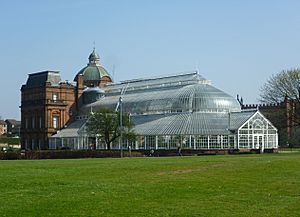
The East End stretches from the city centre to the boundaries of North and South Lanarkshire. It's home to the famous Glasgow Barrowland market, the Barrowland Ballroom, Glasgow Green, and Celtic Park, the home of Celtic FC.
This area was once a major industrial hub with large factories. Today, the Wellpark Brewery, which makes Tennent's Lager, is a notable employer.
The Glasgow Necropolis is a historic cemetery on a hill above the cathedral. St Andrew's in the Square, built in the 1700s, is Scotland's oldest post-Reformation church. The Doulton Fountain in Glasgow Green is also a beautiful landmark.
The East End was home to the Athletes' Village for the 2014 Commonwealth Games, located next to the new Scottish National Indoor Sports Arena.
The Diverse South Side
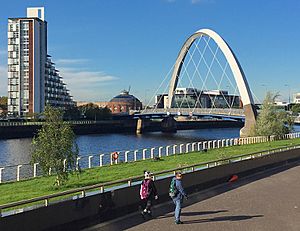
Glasgow's South Side is mostly residential, with a mix of wealthy suburbs and areas with traditional sandstone tenements. Notable buildings include Charles Rennie Mackintosh's Scotland Street School Museum and the Burrell Collection in Pollok Country Park.
The national football stadium, Hampden Park, home of Queens Park FC, and Ibrox Stadium, home of Rangers FC, are both in the South Side.
The Pacific Quay area on the River Clyde is home to the Glasgow Science Centre and the headquarters of BBC Scotland and STV. Several new bridges have been built across the Clyde here, including the Clyde Arc, also known as the "Squinty Bridge."
The South Side has many parks, including Linn Park, Queen's Park, and the large Pollok Country Park, which was named Europe's Best Park in 2008.
Govan is a historic area in the south-west, known for its shipbuilding past. It's home to a BAE Systems shipyard and the Queen Elizabeth University Hospital, one of the country's largest hospitals.
North Glasgow's Transformation
North Glasgow stretches from the city centre towards suburbs like Bearsden and Milngavie. This area has seen a lot of redevelopment, with older housing being replaced or refurbished.
Maryhill is known for its well-kept traditional sandstone buildings. It's also home to Firhill Stadium, where Partick Thistle F.C. plays.
The Forth and Clyde Canal runs through this part of the city. After years of being unused, it has been cleaned up and reopened for navigation, with new art campuses along its banks.
Springburn was once a major industrial area, famous for building locomotives. At one point, 25% of all the world's locomotives were built here. Today, part of the Glasgow Works is still used for railway maintenance.
Glasgow's Vibrant Culture and Arts
Fun and Entertainment in Glasgow
Glasgow offers many cultural activities, from sports to opera and art. In 1990, the city was named European Capital of Culture, celebrating its many cultural sites.
The Mitchell Library is one of Europe's largest public reference libraries, with millions of books and historical documents. The Glasgow University Library is also very old and has unique collections.
Most of Scotland's national arts groups are based in Glasgow, including Scottish Opera, Scottish Ballet, and the Royal Scottish National Orchestra.
Glasgow has its own "Poet Laureate," a special poet chosen to represent the city. In 2013, Glasgow was even named the most vegan-friendly city in the UK!
The Music Scene: A City of Sounds
Glasgow is a hub for music, with many orchestras, bands, and choirs. It has numerous live music venues, pubs, and clubs. Famous venues include the Glasgow Royal Concert Hall, the OVO Hydro, and the historic Barrowland Ballroom.
Many successful bands have come from Glasgow, like Simple Minds, Texas, Franz Ferdinand, and Travis. This has made Glasgow's music scene very famous. In 2008, Glasgow was named a UNESCO City of Music.
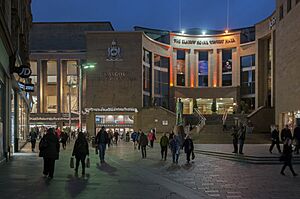
Glasgow has hosted major music awards, including the MOBO Awards in 2009 and the 2014 MTV Europe Music Awards in 2014.
Media and Communication in Glasgow
Many films and TV shows have been made in Glasgow. Both BBC Scotland and STV have their main offices here. Popular TV shows filmed in Glasgow include Taggart, River City, and Still Game.
Glasgow has several newspapers, including The Evening Times and The Herald. Many radio stations also broadcast from the city, such as BBC Radio Scotland and commercial stations like Clyde 1.
Religion in Glasgow
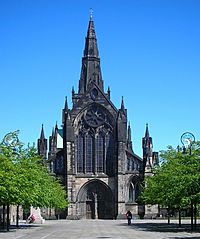
Glasgow is a city with many different religions. The Church of Scotland (Protestant) and the Roman Catholic Church are the largest Christian groups. The city has four Christian cathedrals.
Glasgow also has a significant Muslim population, with the Glasgow Central Mosque being the largest mosque in Scotland. There are also Sikh Gurdwaras, a Hindu Mandir, and Jewish synagogues.
The St Mungo Museum of Religious Life and Art in Glasgow is believed to be the only public museum that explores all the world's major religions.
Glasgow's Unique Architecture
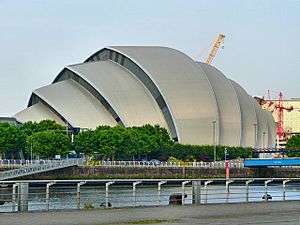
Not much of medieval Glasgow remains, but the 15th-century Provand's Lordship and the 13th-century St. Mungo's Cathedral are important landmarks. Most of the city centre buildings you see today were built in the 19th century. Glasgow has many beautiful Victorian buildings, like the Glasgow City Chambers and the main building of the University of Glasgow.
The city is famous for the architecture of the Glasgow School, especially the work of Charles Rennie Mackintosh. He designed many well-known Glasgow buildings, including the Glasgow School of Art and the Willow Tearooms.
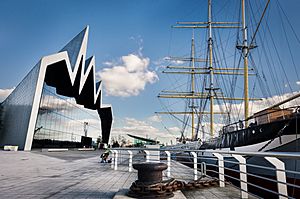
Many of Glasgow's impressive buildings are made of red or blond sandstone. In the past, they were covered in soot from factories, but the Clean Air Act helped clean them up. There are over 1,800 listed buildings in the city, meaning they are important for their history and design.
Modern buildings include the Glasgow Royal Concert Hall and the Glasgow Science Centre. The Clyde Auditorium at the Scottish Exhibition and Conference Centre, designed by Sir Norman Foster, is nicknamed the "Armadillo" because of its shape. The Riverside Museum, designed by Zaha Hadid, opened in 2011 and celebrates Glasgow's industrial heritage.
In 1999, Glasgow was named the UK City of Architecture and Design, showing how much its buildings are appreciated.
Glasgow's Economy and Jobs
How Glasgow Makes Money
Glasgow has the biggest economy in Scotland. Over 410,000 jobs are in the city, across more than 12,000 companies. Between 2000 and 2005, over 153,000 new jobs were created. Glasgow's economy is growing quickly, second only to London in the UK.
While shipbuilding and heavy engineering were once the main industries, Glasgow's economy is now more diverse. Important industries today include public administration, education, healthcare, retail, hotels, restaurants, banking, finance, insurance, transport, and communication. Many large companies still have their headquarters in Glasgow.
Getting Around Glasgow: Transport Links
Public Transport Options
Glasgow has a large public transport system. Many bus services are available, mostly run by private companies. The main bus station is Buchanan bus station.
Glasgow has the biggest urban rail network in the UK outside London. Most trains within Scotland are run by ScotRail. The two main railway stations are Glasgow Central and Queen Street station. Glasgow Central connects to London and other English cities, as well as suburban services. Queen Street station handles services to Edinburgh, Aberdeen, and the Scottish Highlands.

The Glasgow Subway is Scotland's only underground railway. It's the third oldest underground system in the world, after London and Budapest. Both train and subway stations offer park and ride facilities.
A new bus rapid transit system called Clyde Fastlink connects Glasgow City Centre to the Queen Elizabeth University Hospital.
Shipping and Roads
Glasgow's port, the King George V Dock, handles a lot of cargo. The River Clyde is also used for leisure and tourist sailing, including the famous PS Waverley, the world's last working paddle-steamer.
The main M8 motorway goes around the city centre and connects to other major motorways like the M77 and M74. These roads help people travel in and out of the city.
Airports Serving Glasgow
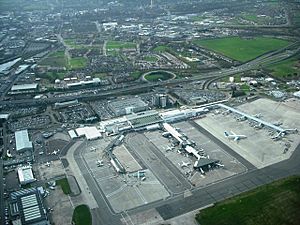
There are three international airports within 45 minutes of Glasgow city centre: Glasgow Airport (8 miles west), Glasgow Prestwick Airport (30 miles southwest), and Edinburgh Airport (34 miles east). There's also a seaplane terminal on the River Clyde.
All these airports are easy to reach by public transport. Glasgow Airport and Edinburgh Airport have direct bus routes from the main bus station, and Glasgow Prestwick Airport has a direct train link from Glasgow Central Station.
Housing in Glasgow
Glasgow is famous for its tenements, which are large buildings divided into many flats. These red and blond sandstone buildings are a key part of the city's look. They were very popular in the 19th and 20th centuries and are still common homes today. People like them for their large rooms and high ceilings. The Hyndland area was the first tenement conservation area in the UK.
In the 1960s, many high-rise tower blocks and large housing estates were built on the edge of the city. These were meant to replace old, crowded tenement areas, which had become slums. However, many of these older tenements have since been renovated and are now desirable homes.
The Glasgow Housing Association now manages much of the city's social housing. They are working to improve housing, including demolishing some high-rise flats and renovating others.
Healthcare in Glasgow
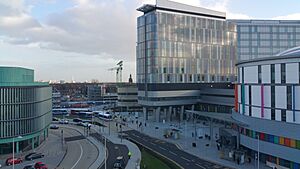
Medical care in Glasgow is mainly provided by NHS Scotland. Major hospitals include the Glasgow Royal Infirmary and the Queen Elizabeth University Hospital (QEUH).
The QEUH, located in Govan, is a huge hospital with 1,677 beds. It includes a large adult hospital, a children's hospital, and two major emergency departments. It's the main trauma centre for west Scotland and one of the largest hospital campuses in Europe.
Glasgow's hospitals also have a strong tradition of teaching new doctors and nurses, working closely with the University of Glasgow Medical School.
Learning and Education in Glasgow
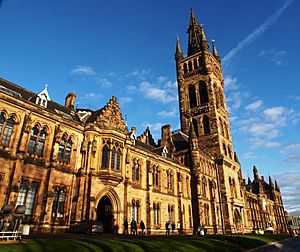
Glasgow is a major centre for higher education and research. It has several universities and colleges:
- University of Glasgow
- University of Strathclyde
- Glasgow Caledonian University
- University of the West of Scotland
- The Glasgow School of Art
- Royal Conservatoire of Scotland
- City of Glasgow College
- Glasgow Clyde College
- Glasgow Kelvin College
- West College Scotland
In 2011, Glasgow had over 53,000 full-time students, more than any other city in Scotland. Many students live in areas like Shawlands and the West End.
The City Council runs many secondary and primary schools, as well as specialist schools like the Dance School of Scotland and the Glasgow Gaelic School, which teaches entirely in Scottish Gaelic. Glasgow also has several independent schools, some of which are very old, like The High School of Glasgow, founded in 1124.
Sports in Glasgow: A City of Champions
Football: The Heartbeat of Glasgow Sports

Glasgow has a rich football history. The world's first international football match was held here in 1872, between Scotland and England.
Glasgow is unique because it's one of the few cities to have had two football teams reach European finals in the same season. In 1967, Celtic won the European Cup, and Rangers reached the Cup Winners' Cup final. Rangers have won more domestic league titles than any other club in the world. Celtic was the first non-Latin club to win the European Cup.
Hampden Park, Scotland's national football stadium, holds the European record for attendance at a football match, with nearly 150,000 fans watching Scotland play England in 1937. Hampden Park has hosted the UEFA Champions League final three times and the UEFA Cup final once. Celtic Park (60,411 seats) and Ibrox Stadium (50,817 seats) are the homes of Celtic and Rangers, respectively.
Glasgow has four professional football clubs in the SPFL: Celtic, Rangers, Partick Thistle, and Queen's Park. The city also has many other football clubs, including women's teams like Glasgow City.
The Scottish Football Association and the Scottish Football Museum are both based in Glasgow.
| Club | Founded | League | Venue | Capacity |
|---|---|---|---|---|
| Celtic F.C. | 1888 | Scottish Premiership | Celtic Park | 60,411 |
| Rangers F.C. | 1872 | Scottish Premiership | Ibrox Stadium | 50,817 |
| Partick Thistle F.C. | 1876 | Scottish Premiership | Firhill Stadium | 10,102 |
| Queen's Park F.C. | 1867 | Scottish League One | Ochilview Park | 3,746 |
Rugby Union in Glasgow
Glasgow has a professional rugby union club, the Glasgow Warriors. They play in major European and international leagues. The Warriors won the Pro12 (now United Rugby Championship) in 2015 and the URC in 2024. Their home stadium is Scotstoun Stadium.
Several other rugby clubs are based in Glasgow, including Glasgow Hawks RFC and Cartha Queen's Park.
Other Popular Sports
Glasgow is home to Scotland's only professional basketball team, the Caledonia Gladiators, who play in the British Basketball League at the Emirates Arena.
The Arlington Baths Club, founded in 1870, is still in use today. It's believed that William Wilson, the club's first Baths Master, invented water polo here.
Glasgow hosts many cricket clubs, including Clydesdale Cricket Club. The city also has artificial ski slopes and golf clubs.
Rowing clubs are active on the River Clyde, and in the past, rowing races attracted huge crowds.
Glasgow as a Host City for Major Sporting Events
Glasgow has hosted many big sporting events. It was the host city for the 2014 Commonwealth Games, with events held at venues like a refurbished Hampden Park, Kelvingrove Park, and the OVO Hydro. The opening ceremony took place at Celtic Park.
In 2018, Glasgow co-hosted the 2018 European Sports Championships. In August 2023, the city hosted the first-ever UCI Cycling World Championships.
On 17 September 2024, Glasgow was chosen to host the 2026 Commonwealth Games, stepping in after the original host pulled out.
Glasgow was also a host city for the pan-European UEFA Euro 2020 football tournament, with matches played at Hampden Park. It will also be a host city for the UEFA Euro 2028 tournament.
Notable Incidents and Events
- 5 April 1902 – 1902 Ibrox disaster: 25 spectators died when a stand collapsed at the Ibrox Park stadium during a football match.
- 2 January 1971 – 1971 Ibrox disaster: 66 people were killed in a crowd crush at Ibrox Stadium.
- 29 November 2013 – 2013 Glasgow helicopter crash: A police helicopter crashed onto The Clutha Vaults Bar, killing all three people on board and seven people in the pub.
- 23 May 2014 – Glasgow School of Art blaze: A fire severely damaged the historic Mackintosh building of the Glasgow School of Art.
- 22 December 2014 – 2014 Glasgow bin lorry crash: Six people were killed when a bin lorry lost control and crashed into pedestrians and buildings.
- 15 June 2018 – Another fire broke out at the Glasgow School of Art, causing extensive damage again.
Glasgow's Global Connections
A Piece of Glasgow on Mars
Did you know there's an area on the planet Mars named Glasgow? NASA named it after Scotland's largest city. The Mars rover Curiosity has even drilled at this site!
Twin Towns and Partnerships
Glasgow is "twinned" with several cities around the world, meaning they have special friendly relationships:
- Nuremberg, Germany (since 1985)
- Dalian, China (since 1997)
- Havana, Cuba (since 2002)
- Turin, Italy (since 2003)
- Marseille, France (since 2006)
- Lahore, Pakistan (since 2006)
- Bethlehem, Palestine (since 2007)
- Mykolaiv, Ukraine (since 2024)
The city also has partnerships with:
- Berlin, Germany (since 2020)
- Oulu, Finland
- Pittsburgh, United States (since 2020)
- Santiago, Chile (since 2020)
Images for kids
-
The University of Glasgow in the 1890s.
-
George Square in 1966, showing the city's changing look.
-
The People's Palace museum and Winter Garden on Glasgow Green.
-
Pacific Quay on the south side of Glasgow, home to major businesses.
-
Ruchill Church, seen from the Forth and Clyde Canal.
-
The Glasgow Royal Concert Hall, a major music venue.
-
Pacific Quay is home to BBC Scotland, a main broadcaster.
-
The Herald building on Albion Street.
-
Glasgow Cathedral stands on the site where Saint Mungo built his first church.
-
The SEC Armadillo's design is inspired by Glasgow's shipbuilding past.
-
The Riverside Museum on the banks of the River Clyde.
-
The Red Road Flats (far right) were once Europe's tallest residential buildings.
-
Glasgow Central Station, a major rail hub.
-
The Glasgow Subway is Scotland's only underground railway.
-
The M8, crossing the Clyde over the Kingston Bridge, is Scotland's busiest motorway.
-
Glasgow Airport is the largest airport serving the city.
-
The Queen Elizabeth University Hospital is one of Europe's largest hospital campuses.
-
The University of Glasgow is one of the oldest universities in the English-speaking world.
-
Hampden Park is Scotland's national football stadium.
See also
 In Spanish: Glasgow para niños
In Spanish: Glasgow para niños


